Spiritual Meaning of Head Wraps: Identity and Protection
Head wraps are imbued with profound spiritual and cultural significance across various traditions. Historically, they have symbolized social status, religious adherence, and ethnic identity.
In African, South Asian, and other global communities, the material, color, and wrapping style convey specific social messages, spiritual beliefs, and ancestral connections. Additionally, head wraps often accompany rituals and ceremonies, underscoring their sacred nature.
They play pivotal roles in gender delineation, protection, and healing practices. These multifaceted symbols continue to evolve, merging traditional meanings with contemporary expressions, offering insights into their enduring importance in spiritual and cultural contexts.
Learn about the intricate layers of this tradition.
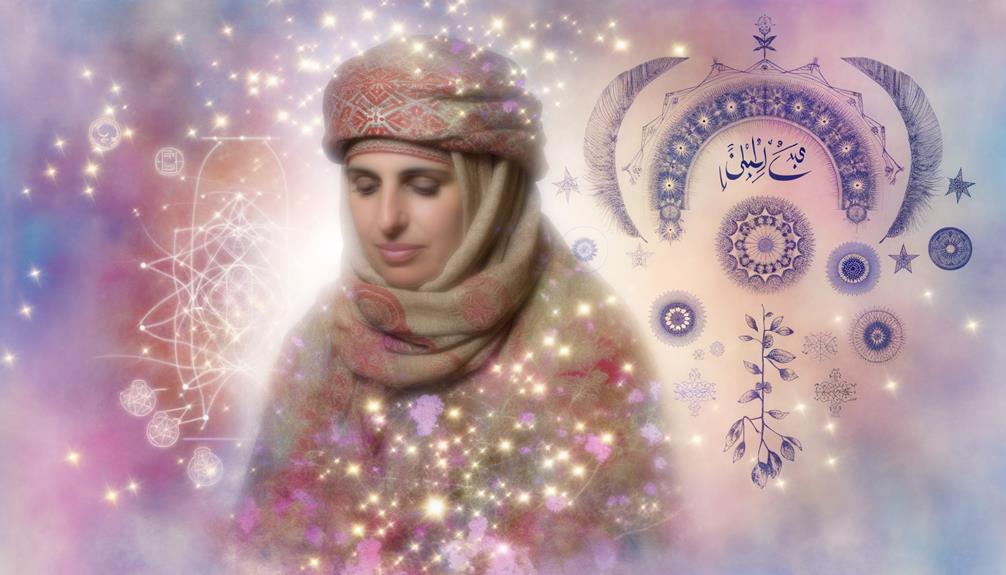
Spiritual Meaning of Head Wraps: Symbolism and Cultural Significance
| Symbolism | Meaning |
|---|---|
| Protection | Believed to shield the wearer from negative energy or spiritual harm |
| Modesty and Humility | Signifies inner discipline, spiritual devotion, and respect |
| Identity and Heritage | Represents cultural pride and ancestral connection |
| Sacred Practice | Used in rituals and ceremonies to invoke spiritual presence |
| Wisdom and Enlightenment | Indicates maturity, knowledge, and elevated spiritual awareness |
Historical Significance
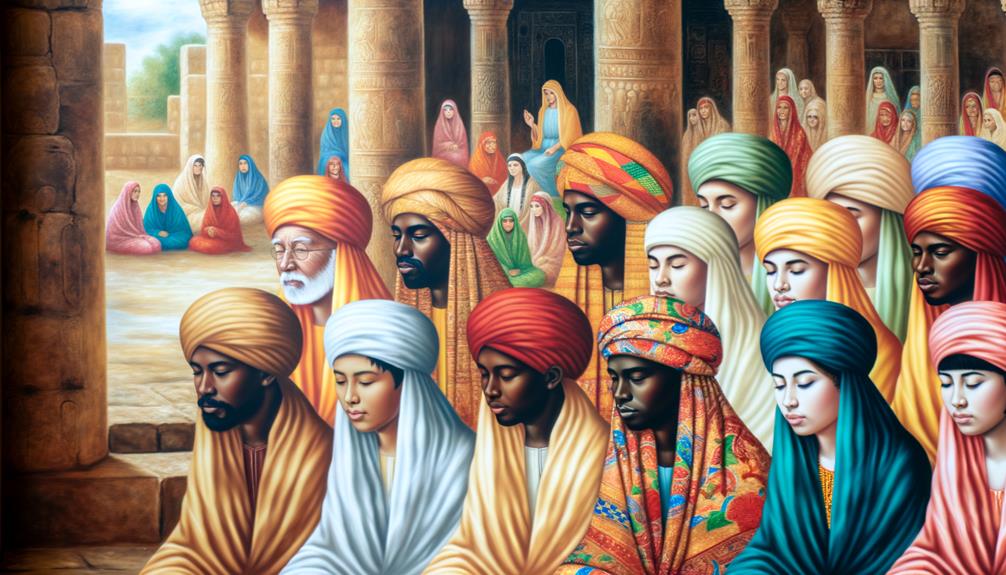
Throughout history, head wraps have served as powerful cultural symbols across various civilizations, reflecting social status, religious beliefs, and ethnic identity.
In ancient Egypt, for instance, pharaohs adorned themselves with intricately designed nemes, signifying their divine authority and connection to the gods.
Similarly, in the Yoruba culture of Nigeria, head wraps known as geles have been used to denote marital status and social hierarchy.
In medieval Europe, veils and wimples worn by women often indicated piety and modesty, influenced by Christian doctrines.
The historical significance of head wraps extends beyond mere fashion; they have been integral in expressing societal norms and values.
This rich tapestry of usage highlights the diverse roles head wraps have played throughout various epochs and cultures.
Cultural Identity
Head wraps serve as potent symbols of cultural identity, encapsulating the unique traditions, values, and histories of the communities that wear them.
These garments are not mere fashion accessories but are deeply ingrained in the socio-cultural fabric of various ethnic groups. They often signify social status, marital status, or regional affiliation, acting as a visual representation of one’s heritage.
In many African and South Asian cultures, for example, head wraps are intricately tied to community practices and customs, often passed down through generations.
Additionally, the choice of fabric, color, and wrapping style can convey specific messages and emotions, further underscoring the head wrap’s role in maintaining and expressing cultural identity.
Consequently, head wraps serve as a tactile link to ancestral legacies.
Symbol of Faith

The use of head wraps often serves as a profound symbol of faith, reflecting an individual’s religious identity and adherence to specific spiritual practices.
These coverings can signify devotion and observance within various cultural contexts, acting as tangible expressions of belief.
Additionally, head wraps are frequently integrated into devotional practices, underscoring their importance in spiritual and religious life.
Religious Identity Expression
For many religious communities, head wraps serve as a tangible expression of faith and spiritual identity. These garments are not merely aesthetic but carry deep spiritual significance, symbolizing humility, piety, and adherence to religious doctrines. Recognizing these meanings requires an understanding of various religious traditions. Below is a table that highlights diverse religious perspectives on head wraps.
| Religion | Significance of Head Wraps | Purpose |
|---|---|---|
| Islam | Modesty and obedience to Allah | Hijab as a form of modesty |
| Judaism | Reverence and respect in worship | Tichel worn during prayer |
| Christianity | Submission and honor to God | Veil or head covering in church |
| Sikhism | Equality and spirituality | Turban as a symbol of faith |
| Hinduism | Respect and tradition | Scarf worn during religious rituals |
Understanding these contexts enriches one’s appreciation for the multifaceted role head wraps play in religious identity.
Cultural Spiritual Practices
Frequently, head wraps transcend religious boundaries and become emblematic of broader cultural spiritual practices, serving as potent symbols of faith and identity.
In various cultures, these garments are imbued with profound spiritual significance, often intertwined with rites of passage, ancestral reverence, and communal belonging.
Among African and African Diaspora communities, for instance, head wraps symbolize resilience and continuity, connecting individuals to their heritage and spiritual roots.
Similarly, in South Asian practices, such coverings can denote sacredness and respect during spiritual rituals.
Devotional Head Coverings
In many traditions, head wraps serve as devotional coverings that symbolize an individual’s faith and commitment to their spiritual beliefs. These coverings are not merely decorative but are imbued with profound religious significance.
For example, in Christianity, head coverings like veils are often worn during prayer as a sign of humility and reverence before God. In Islam, the hijab represents modesty and piety, reflecting adherence to divine commandments. Similarly, in Sikhism, turbans signify equality and respect for spiritual tenets.
The act of covering one’s head in these contexts transcends cultural norms, acting as a visible manifestation of inner devotion and discipline. Consequently, head wraps function as both personal and communal symbols of unwavering faith and spiritual adherence.
Protection and Healing
Head wraps serve as both a cultural artifact and a spiritual tool, often believed to offer protection and facilitate healing through their symbolic and practical uses.
Historically, head wraps have been employed to shield individuals from physical and metaphysical harm. Materials and colors are carefully chosen to invoke protective energies, acting as barriers against negative influences.
Additionally, certain traditions utilize head wraps in healing rituals, wherein the act of covering the head is seen as a means to preserve one’s spiritual energy and promote mental clarity.
The practice is not merely ornamental but deeply rooted in the belief that the head, as a crucial energy center, requires safeguarding to maintain overall well-being.
Consequently, head wraps embody a multifaceted approach to spiritual health.
Connection to Ancestors
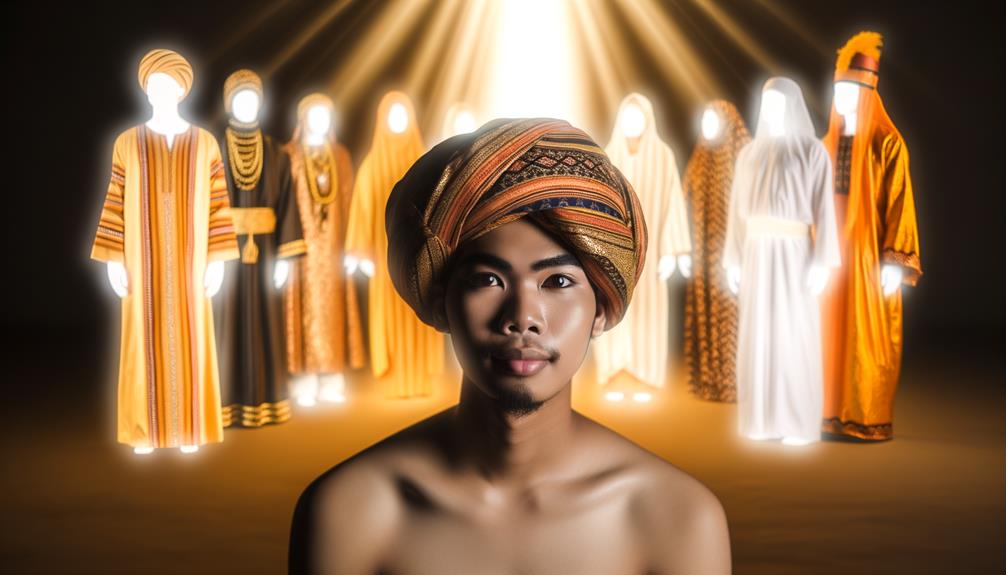
Many cultures view head wraps as a tangible link to their ancestors, serving as a powerful symbol of heritage and continuity.
The practice of wearing head wraps often transcends mere fashion, embodying deep-seated traditions passed down through generations.
In various African, Asian, and Indigenous communities, head wraps are imbued with ancestral significance, often crafted with patterns and colors that hold historical and familial meanings.
These garments act as a conduit for spiritual connection, fostering a sense of belonging and honoring one’s lineage.
Within this framework, head wraps are not only a reflection of cultural identity but also a means of preserving and venerating ancestral wisdom and practices, thereby reinforcing the enduring bond between past and present generations.
Social Status Indicators
How do head wraps serve as indicators of social status within various cultural contexts?
In numerous societies, head wraps are more than mere accessories; they function as visual markers of an individual’s rank, wealth, or community role.
For instance, in West African cultures, the intricacy and fabric of a head wrap can signify one’s social hierarchy, with more elaborate designs often reserved for nobility or affluent members.
Similarly, in South Asian traditions, specific styles and colors of head wraps may denote caste or professional standing.
The material used—ranging from simple cotton to luxurious silk—also conveys socioeconomic status.
Consequently, head wraps act as multifaceted symbols, embedding within their folds a rich tapestry of social stratification and cultural identity.
Gender and Head Wraps
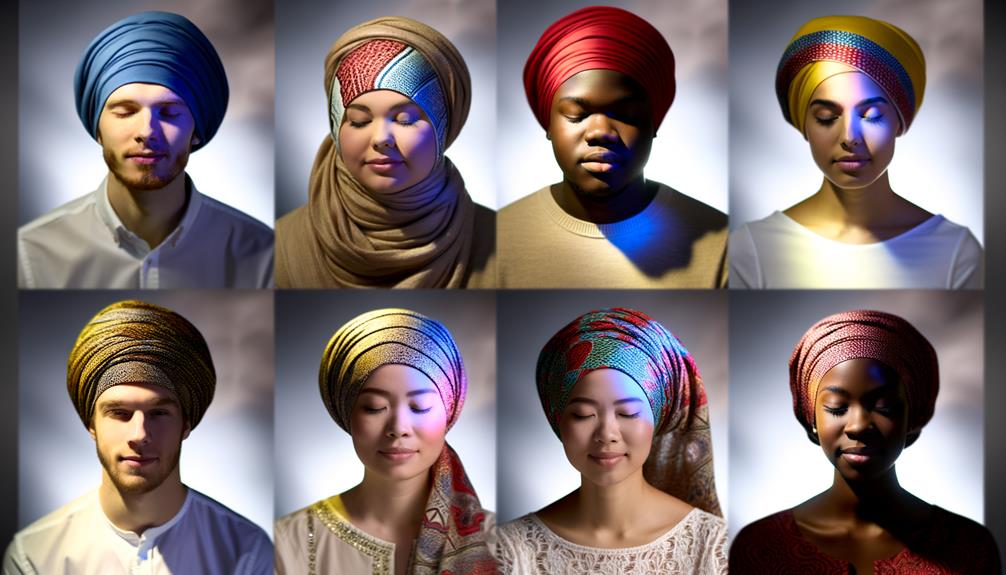
In various cultural contexts, head wraps serve as significant markers of gender, often delineating roles, responsibilities, and societal expectations.
For instance, in many African societies, women’s head wraps are not merely ornamental but symbolize marital status, maturity, and respectability. In contrast, male head wraps can signify leadership or spiritual authority, often imbued with symbolic colors and patterns denoting these roles.
Additionally, in some Middle Eastern cultures, head wraps for men and women differ in design and purpose, reflecting distinct gender norms and religious tenets.
Such practices highlight how head wraps function as complex semiotic tools, communicating gender-specific messages that transcend mere aesthetics, thereby reinforcing social structures and cultural heritage through a tangible, visible medium.
Ritualistic Uses
Ritualistic uses of head wraps encompass a range of applications, including ceremonial symbolism, ancestral connection, and sacred practices.
These uses highlight the head wrap’s role in religious and cultural ceremonies, serving as a tangible link to heritage and spiritual traditions.
Understanding these aspects offers a thorough perspective on the head wrap’s significance beyond its aesthetic value.
Ceremonial Symbolism
Head wraps often serve as powerful symbols in various ceremonial contexts, embodying cultural, spiritual, and religious significance.
In many traditions, they represent a form of sacred attire that demarcates significant life events such as weddings, funerals, and rites of passage.
The specific style, color, and material of a head wrap can denote different roles or statuses within a community, such as priesthood, royalty, or marital status.
For instance, in certain African cultures, the intricacies of head wrap designs are meticulously chosen to convey the wearer’s identity and spiritual state during rituals.
Similarly, in Hindu ceremonies, head wraps may symbolize purity and divine connection.
Consequently, head wraps function as tangible expressions of intangible beliefs and customs, enriching ceremonial practices worldwide.
Ancestral Connection
Through the ritualistic use of head wraps, individuals often seek to establish a profound connection with their ancestors, invoking heritage and ancestral wisdom.
These head wraps are not merely decorative but serve as tangible links to lineage and tradition. In various cultures, specific styles, colors, and materials are chosen to honor and remember forebears.
The act of wrapping the head can be a meditative practice, symbolizing respect and continuity with ancestral spirits. This practice often accompanies ceremonies, rites of passage, and other culturally significant events, reinforcing communal bonds and shared histories.
Consequently, the head wrap becomes a powerful conduit through which the living engage with the spiritual legacy of their predecessors, fostering a sense of belonging and identity.
Sacred Practices
In various spiritual traditions, the use of head wraps during sacred practices serves to enhance the sanctity of rituals and ceremonies, imbuing the act with deeper spiritual significance.
Head wraps often symbolize purity, humility, and a connection to the divine, creating a physical manifestation of one’s devotion and reverence.
For instance, in many African and Indigenous cultures, head wraps are worn during prayer, meditation, and other spiritual observances to signify a state of spiritual readiness and protection.
Additionally, the act of wrapping the head can be seen as a ritual in itself, marking the shift from the mundane to the sacred.
This practice underscores the importance of intention, as the head wrap becomes a conduit for channeling spiritual energy and focus.
Modern Interpretations
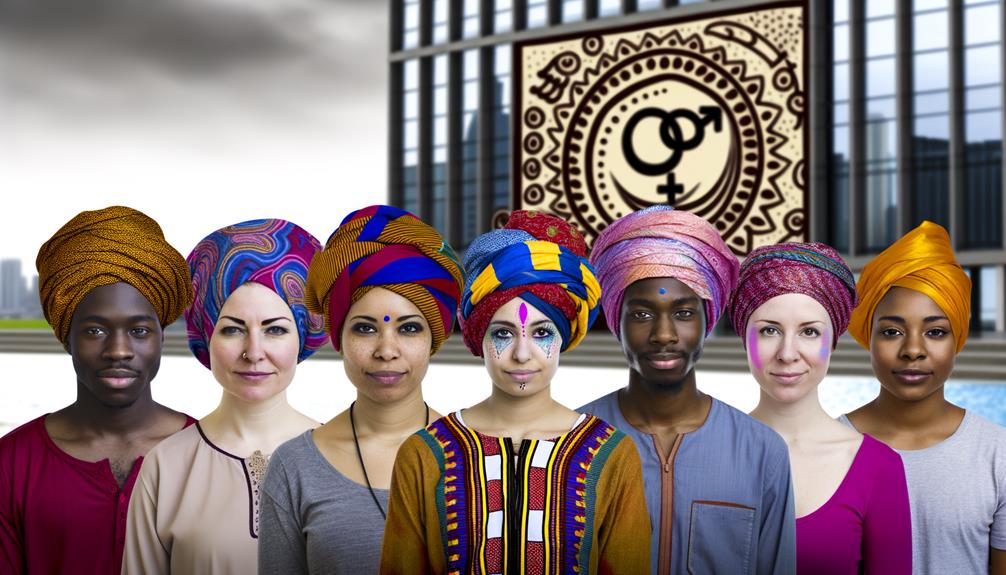
Contemporary interpretations of head wraps often merge traditional cultural significance with modern fashion trends, reflecting a dynamic interplay between heritage and personal expression.
This evolution is evident as individuals incorporate head wraps into their daily attire, not solely as cultural artifacts but also as symbols of identity and style.
In modern contexts, head wraps can serve as statements of solidarity, empowerment, and resistance against cultural erasure.
Additionally, the accessibility of diverse fabrics and designs allows for personalized adaptation that respects historical roots while embracing contemporary aesthetics.
This fusion highlights how head wraps extend beyond mere fashion accessories, embodying a rich tapestry of cultural continuity and individualism that resonates across varied global communities.
Conclusion
The spiritual meaning of head wraps transcends mere aesthetics, serving as profound symbols of historical significance, cultural identity, faith, and protection.
Like a thread weaving through the fabric of human experience, head wraps connect individuals to their ancestors and social structures, while embodying gender roles and ritualistic practices.
In contemporary contexts, these head wraps continue to evolve, reflecting both continuity and change.
Their multifaceted meanings persist, offering a rich tapestry of spiritual and cultural expression.






